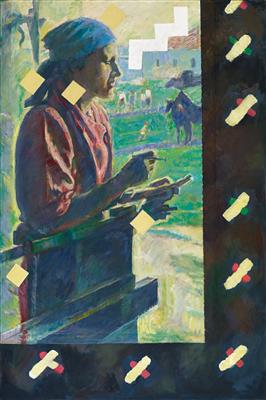Ilya Kabakov

(Dnjepropetrovsk/Ucraina 1933 nato; vive e lavora a New York)
agazza con bilancia, 1972, 2002, olio su tela, 138 x 89 cm, sul retro in cirillico firmato, datato e intitolato Ilya Kabakov 2002, con cornice, (PS)
Provenienza:
L’artista stesso,
Galerie Michael Kewenig, Colonia
Collection Tom and Yvette Moeskops, Olanda
L’opera è registrata in archivio con il numero 371.
Bibliografia:
Renate Petzinger e Emilia Kabakov (a cura di), Ilya Kabakov, Paintings/dipinto 1957–2008, Catalogue Raisonné, vol. II, Museum Wiesbaden, Kerber Verlag, 2008, p.134, n. 414.
Catalogo della mostra Ilya/ Emilia Kabakov, An alternative history of art, Rosenthal, Kabakov, Spivak, Museum of Contemporary Art Cleveland, Bielefeld 2005, p.166 (riprod. a colori.)
Esposizioni/Cataloghi:
Cleveland Ott. Museum of Contemporary Art, The teacher and the student, Charles Rosenthal and Ilya Kabakov, a cura di Jill Synder, direttrice del Moca Cleveland,10-9-2004 – 2-1-2005
The State Pushkin Museum of Fine Arts, Center for Contemporary Culture Garage, Winzavod Mosca Contemporary Art Center, Mosca, Ilya and Emilia Kabakov, Retrospective, 15-9/18-10-2008, organized by the Ministry of Culture and Cinematography and the Moscow Biennale Foundation (3 catalogues)
La “Ragazza con bilancia” fa parte della grande installazione di Ilya Kabakov esposta per la prima volta nel 2004 con il titolo “The Teacher and his Student: Charles Rosenthal e Ilya Kabakov” al Museum of Contemporary Art, Cleveland. La situazione politica nella Russia degli anni ’70 obbligò molti artisti a cercare una relazione dialettica fra se stessi e il mondo circostante. Questo dilemma viene affrontato da Kabakov nella sua esposizione “The Teacher and his Student” creando un alter ego, Charles Rosenthal, e ambientando la propria opera nell’Unione Sovietica degli anni ‘70. Le opere che egli ha firmato “Kabakov” sono datate tra il 1970 e il 1975. Questa serie va letta come una parafrasi delle opere di Rosenthal, viste da Kabakov in “originale” e potrebbe intitolarsi “If Rosenthal had lived in Russia during the 1970s...”. “The white backgrounds behind the new reality of the 1920s can be interpreted as a space of the ‘bright future’, a space of ‘hope’ that not only Rosenthal desired to see in the post-revolutionary period, but so did many European intellectuals at the beginning of the 20th century. Kabakov belonged to another generation that had grown up in the USSR, a generation that had no more ‘bright hopes’, neither in the present nor even more so, in the future. Therefore he replaces the white space behind Rosenthal’s paintings with a dark, murky gloom. Something is going on in this space, it is rustling about; there is some kind of infinite, unfathomable chaos living beyond the fine film of visible reality attempts to hide what might be seen behind it, and the viewer is left with the impression of a kind of balancing between these two things (ibid. p. 162).
” Kabakov fa vedere a noi osservatori solo un piccolo ritaglio del tutto, i margini sono occupati da traverse scure con elementi colorati, che emergono con scansione geometrica in tutto il quadro. Come quando da una finestra nel buio si guarda l’abbagliante luce solare, Kabakov concede all’osservatore di gettare uno sguardo sulla vita rurale deli abitanti dell’Unione Sovietica degli anni ’70. Intelligenza e collettività comunista stanno l’una di fronte all’altra con differente illuminazione e si ritrovano unite in ”Ragazza con bilancia”.
(Catalogo della mostra Ilya/ Emilia Kabakov, An alternative history of art, Rosenthal, Kabakov, Spivak, Museum of Contemporary Art Cleveland, Bielefeld 2005, p. 147 e seguenti)
Esperta: Dr. Petra Maria Schäpers
 Dr. Petra Maria Schäpers
Dr. Petra Maria Schäpers
petra.schaepers@dorotheum.de
20.05.2014 - 19:00
- Prezzo realizzato: **
-
EUR 366.300,-
- Stima:
-
EUR 300.000,- a EUR 400.000,-
Ilya Kabakov
(Dnjepropetrovsk/Ucraina 1933 nato; vive e lavora a New York)
agazza con bilancia, 1972, 2002, olio su tela, 138 x 89 cm, sul retro in cirillico firmato, datato e intitolato Ilya Kabakov 2002, con cornice, (PS)
Provenienza:
L’artista stesso,
Galerie Michael Kewenig, Colonia
Collection Tom and Yvette Moeskops, Olanda
L’opera è registrata in archivio con il numero 371.
Bibliografia:
Renate Petzinger e Emilia Kabakov (a cura di), Ilya Kabakov, Paintings/dipinto 1957–2008, Catalogue Raisonné, vol. II, Museum Wiesbaden, Kerber Verlag, 2008, p.134, n. 414.
Catalogo della mostra Ilya/ Emilia Kabakov, An alternative history of art, Rosenthal, Kabakov, Spivak, Museum of Contemporary Art Cleveland, Bielefeld 2005, p.166 (riprod. a colori.)
Esposizioni/Cataloghi:
Cleveland Ott. Museum of Contemporary Art, The teacher and the student, Charles Rosenthal and Ilya Kabakov, a cura di Jill Synder, direttrice del Moca Cleveland,10-9-2004 – 2-1-2005
The State Pushkin Museum of Fine Arts, Center for Contemporary Culture Garage, Winzavod Mosca Contemporary Art Center, Mosca, Ilya and Emilia Kabakov, Retrospective, 15-9/18-10-2008, organized by the Ministry of Culture and Cinematography and the Moscow Biennale Foundation (3 catalogues)
La “Ragazza con bilancia” fa parte della grande installazione di Ilya Kabakov esposta per la prima volta nel 2004 con il titolo “The Teacher and his Student: Charles Rosenthal e Ilya Kabakov” al Museum of Contemporary Art, Cleveland. La situazione politica nella Russia degli anni ’70 obbligò molti artisti a cercare una relazione dialettica fra se stessi e il mondo circostante. Questo dilemma viene affrontato da Kabakov nella sua esposizione “The Teacher and his Student” creando un alter ego, Charles Rosenthal, e ambientando la propria opera nell’Unione Sovietica degli anni ‘70. Le opere che egli ha firmato “Kabakov” sono datate tra il 1970 e il 1975. Questa serie va letta come una parafrasi delle opere di Rosenthal, viste da Kabakov in “originale” e potrebbe intitolarsi “If Rosenthal had lived in Russia during the 1970s...”. “The white backgrounds behind the new reality of the 1920s can be interpreted as a space of the ‘bright future’, a space of ‘hope’ that not only Rosenthal desired to see in the post-revolutionary period, but so did many European intellectuals at the beginning of the 20th century. Kabakov belonged to another generation that had grown up in the USSR, a generation that had no more ‘bright hopes’, neither in the present nor even more so, in the future. Therefore he replaces the white space behind Rosenthal’s paintings with a dark, murky gloom. Something is going on in this space, it is rustling about; there is some kind of infinite, unfathomable chaos living beyond the fine film of visible reality attempts to hide what might be seen behind it, and the viewer is left with the impression of a kind of balancing between these two things (ibid. p. 162).
” Kabakov fa vedere a noi osservatori solo un piccolo ritaglio del tutto, i margini sono occupati da traverse scure con elementi colorati, che emergono con scansione geometrica in tutto il quadro. Come quando da una finestra nel buio si guarda l’abbagliante luce solare, Kabakov concede all’osservatore di gettare uno sguardo sulla vita rurale deli abitanti dell’Unione Sovietica degli anni ’70. Intelligenza e collettività comunista stanno l’una di fronte all’altra con differente illuminazione e si ritrovano unite in ”Ragazza con bilancia”.
(Catalogo della mostra Ilya/ Emilia Kabakov, An alternative history of art, Rosenthal, Kabakov, Spivak, Museum of Contemporary Art Cleveland, Bielefeld 2005, p. 147 e seguenti)
Esperta: Dr. Petra Maria Schäpers
 Dr. Petra Maria Schäpers
Dr. Petra Maria Schäpers
petra.schaepers@dorotheum.de
|
Hotline dell'acquirente
lun-ven: 10.00 - 17.00
kundendienst@dorotheum.at +43 1 515 60 200 |
| Asta: | Arte contemporanea, parte 1 |
| Tipo d'asta: | Asta in sala |
| Data: | 20.05.2014 - 19:00 |
| Luogo dell'asta: | Vienna | Palais Dorotheum |
| Esposizione: | 10.05. - 20.05.2014 |
** Prezzo d'acquisto comprensivo di tassa di vendita e IVA
Non è più possibile effettuare un ordine di acquisto su Internet. L'asta è in preparazione o è già stata eseguita.
